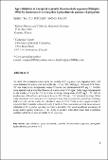| dc.contributor.author | Njiru, M. | |
| dc.contributor.author | Pitcher, T. J. | |
| dc.contributor.author | Pauly, D. | |
| dc.date.accessioned | 2018-02-23T13:17:07Z | |
| dc.date.available | 2018-02-23T13:17:07Z | |
| dc.date.issued | 2000 | |
| dc.identifier.uri | http://hdl.handle.net/11671/1949 | |
| dc.description.abstract | To verify that increments observed in the otoliths of R. argentea were deposited daily, fish
were immersed in tetracycline hydrochloride (TC) of 100 - 600 mg V between 2-24 hours.
TC was found to be incorporated within 12 hours after immersion in 600 mg L·1• Otoliths
were marked with a band that fluoresced in ultraviolet (UV) light Daily rings corresponded
to the number of days the fish lived after marking. Strong dose of 600 mg L-1 TC did not
produce arty diffuse bands and weaker doses of 100-500 mg L:' TC produced no rings. When daily increments were assumed to be deposited more than once per day, growth performance index (0') did not lie within the calculated mean (± S.D). These results suggested that R. argentea likely deposits increments daily. Counts of daily increments provide more accurate estimates of R. argentea age than previously available. The most significant advantage of using otolith ageing technique is the ability to produce individual rather than population statistics which have been available for R. argentea | en_US |
| dc.language.iso | en | en_US |
| dc.publisher | LVFO | en_US |
| dc.relation.ispartofseries | Volume;10 | |
| dc.subject | Fisheries | en_US |
| dc.subject | Fish Species | en_US |
| dc.title | Age validation of a tropical cyprinid, Rastrineobola argentea (Pellegrin 1904) by immersin in tetracycline hydrochloride and use phi prime | en_US |
| dc.type | Article | en_US |

